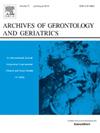肯纳德效应有临床证据支持吗?
IF 3.5
3区 医学
Q2 GERIATRICS & GERONTOLOGY
引用次数: 0
摘要
该研究的目的是评估所谓的肯纳德效应,即康复与年龄之间存在负相关关系。38例首次中风的老年患者(中位年龄71岁,范围60-81岁)被纳入研究。中风后的平均间隔时间为15天。患者进入了一个为期60天的康复计划。采用功能独立性测量法(FIM)评价其功能状态。仅考虑入学时低于36的FIM值。所有病例均行计算机断层扫描(CT)或磁共振成像(MRI)扫描。病灶类型为缺血性24例,出血性7例,多发病灶7例。一年后,我们联系了患者家属进行随访,他们都表示同意。幸存者再次接受了检查。出院时的FIM评分与随访时的FIM评分采用Wilcoxon检验(双侧)进行统计学比较。整个人群入院时的FIM值中位数为27.5。这些患者在我们康复中心住院期间均未死亡,出院时FIM值中位数为34.5,该值仍然表明残疾程度高。一年后,22人仍在家中存活(57.9%)。他们的FIM中位数为46。与出院组比较差异有统计学意义(Z = -3.228, p = 0.001)。三名患者的得分分别为85分、87分和88分,尽管他们都没有接受康复治疗。总之,我们的研究结果表明,尽管有既往卒中和现有合并症,老年患者的恢复性过程仍然活跃。本组部分老年患者虽入院时FIM值很低,但仍可接近独立生活。本文章由计算机程序翻译,如有差异,请以英文原文为准。
IS THE KENNARD EFFECT SUPPORTED BY CLINICAL EVIDENCE?
求助全文
通过发布文献求助,成功后即可免费获取论文全文。
去求助
来源期刊
CiteScore
7.30
自引率
5.00%
发文量
198
审稿时长
16 days
期刊介绍:
Archives of Gerontology and Geriatrics provides a medium for the publication of papers from the fields of experimental gerontology and clinical and social geriatrics. The principal aim of the journal is to facilitate the exchange of information between specialists in these three fields of gerontological research. Experimental papers dealing with the basic mechanisms of aging at molecular, cellular, tissue or organ levels will be published.
Clinical papers will be accepted if they provide sufficiently new information or are of fundamental importance for the knowledge of human aging. Purely descriptive clinical papers will be accepted only if the results permit further interpretation. Papers dealing with anti-aging pharmacological preparations in humans are welcome. Papers on the social aspects of geriatrics will be accepted if they are of general interest regarding the epidemiology of aging and the efficiency and working methods of the social organizations for the health care of the elderly.

 求助内容:
求助内容: 应助结果提醒方式:
应助结果提醒方式:


